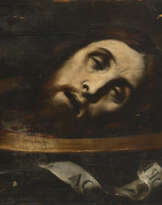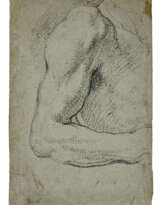ID 1071534
Lot 13 | DANIELE CRESPI (BUSTO ARSIZIO 1598-1630 MILAN)
Estimate value
€ 40 000 – 60 000
Portrait d'un homme, en buste
huile sur panneau
47 x 37,7 cm. (18 ½ x 14 7⁄8 in.)
Provenance
Peut-être collection Camilla, Lombardie (selon un cachet au revers du panneau).
Galleria Cantarini (no. inv. 129) (selon une inscription au revers du panneau).
Vente anonyme, Phillips, Londres, 15 avril 1997, lot 91 (comme 'studio of Domenico Feti').
Collection Koelliker, Milan.
Edmondo di Robilant ; d'où acquis par l'actuel propriétaire en mars 2012.
Literature
F. Frangi, 'Un vertice giovanile di Daniele Crespi', in M. Ceriana, F. Mazzocca, Itinerari d'arte in Lombardia dal XIII al XX secolo. Scritti offerti a Maria Teresa Binaghi Olivari, Milan, 1998, p. 221, sous la note 10 (comme 'Daniele Crespi').
F. Frangi, Dipinti lombardi del Seicento. Collezione Koelliker, Turin, 2004, pp. 82-83, reproduit en couleurs p. 83 (comme 'Daniele Crespi').
Exhibited
Milan, Palazzo Reale, L'Anima e il Volto. Ritratto e fisiognomica da Leonardo a Bacon, 30 octobre 1998-14 mars 1999 (comme 'Daniele Crespi').
Varese, Castello di Masnago, Il ritratto in Lombardia da Moroni a Ceruti, 21 avril-14 juillet 2002, n°40 (comme 'Daniele Crespi').
Milan, Palazzo Reale, Maestri del '600 e del '700 lombardo nella collezione Koelliker, 1er avril-2 juillet 2006, n°21 (comme 'Daniele Crespi').
New York, Robilant+Voena chez Sperone Westwater, Portraits / Self-portraits, from the 16th to the 21st Century, 12 janvier-25 février 2012 (comme 'Daniele Crespi').
Further Details
DANIELE CRESPI, PORTRAIT OF A GENTLEMAN, BUST-LENGTH, OIL ON PANEL
Best known for his religious works, Daniele Crespi (1598-1630) was much in demand for his distinctive style, which represented a turning point between late Mannerism and the fertile Lombard Caravaggism. Some of his greatest works can still be seen in situ at the Carthusian monastery of Saint Ambrose in Garegnano, Milan, and in Pavia.
As well as being a brilliant painter of religious scenes, Crespi was also renowned for his profound portraits of singular intensity. The attribution of the present portrait, discovered in the late 1990s, was confirmed soon after its reappearance by the historian Franco Moro (F. Moro in L'Anima e il Volto. Ritratto e fisiognomica da Leonardo a Bacon, [exp. cat.], Milan, 1998, p. 234).
Though the execution of the portrait may seem to depart from the artist’s more fluid treatment of the faces of younger men, such as that of an anonymous sculptor in the Pinacoteca Brera, Milan (inv. no. Reg. Cron. 405), this is because the painter skilfully adapted a rougher style to the features of his model. The same lively execution with its incisive brushstrokes can be found in another portrait of an elderly man wearing a ruff, also in Milan (see N. W. Neilson, Daniele Crespi, Soncino, 1996, p. 39, no. 25).
The Milanese portrait, considered by Nancy W. Neilson to be a late work in the artist’s oeuvre, suggests a possible date for the present portrait of the late 1620s. At this time, the artist was reaching the zenith of his powers, exploring more dramatic chiaroscuro and vibrant realism. Unfortunately, Crespi would not have the opportunity to continue in this vein, destined for great success, as he was struck down by the plague of 1630.
| Artist: | Daniele Crespi (1598 - 1630) |
|---|---|
| Applied technique: | Oil on panel |
| Art style: | Old Masters |
| Genre: | Portrait |
| Place of origin: | Italy, Europe |
| Auction house category: | Paintings |
| Artist: | Daniele Crespi (1598 - 1630) |
|---|---|
| Applied technique: | Oil on panel |
| Art style: | Old Masters |
| Genre: | Portrait |
| Place of origin: | Italy, Europe |
| Auction house category: | Paintings |
| Address of auction |
CHRISTIE'S 9 Avenue Matignon 75008 Paris France | ||||||||||||||
|---|---|---|---|---|---|---|---|---|---|---|---|---|---|---|---|
| Preview |
| ||||||||||||||
| Phone | +33 (0)1 40 76 85 85 | ||||||||||||||
| Fax | +33 (0)1 40 76 85 86 | ||||||||||||||
| Conditions of purchase | Conditions of purchase | ||||||||||||||
| Shipping |
Postal service Courier service pickup by yourself | ||||||||||||||
| Payment methods |
Wire Transfer | ||||||||||||||
| Business hours | Business hours
|







